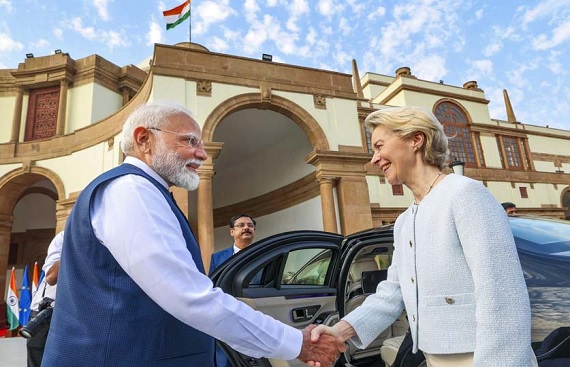India and Europe Race to Seal a Deal Amid Trump's Trade Blitz
By
siliconindia | Monday, 10 March 2025, 00:26 Hrs

India and the EU have begun a critical round of free trade agreement (FTA) talks in Brussels, which is intended to reduce the influence of Donald Trump's aggressive tariff strategy. While both sides are competing to close the deal before the end of the year, Prime Minister Narendra Modi and European Commission President Ursula von der Leyen believe the FTA is an economic counterbalance of crucial importance to US pressure.
European negotiators are pressuring India to reduce tariffs on major products such as dairy, wine, and cars. European wine producers are campaigning to reduce India's 150 percent tariff on foreign wines to 30-40 percent, while automobile manufacturers such as BMW and Mercedes-Benz are seeking the reduction of the 100-125 percent duty on completely built-up vehicles to 10-20 percent.
At the same time, Trump's ultimatums are driving India towards a possible trade policy transformation. The US President has labeled India's tariffs as 'massive' and 'unfair' and asserted last week that India had 'agreed' to reduce duties. "They want to reduce their tariffs way down now", Trump said, giving April 2 as the deadline for tit-for-tat tariffs on nations with high levies on US goods.
The US wants India to cut tariffs to near-zero levels across most sectors, excluding agriculture. India’s average tariff on US goods is around 12 percent, compared to the US average of 2.2 percent on Indian imports. Washington also wants GST reductions on items like medical devices and electronics, arguing that current rates are discriminatory.
India's commerce minister Piyush Goyal has been pushing bilateral trade talks in the US. The talks, according to Randhir Jaiswal, ministry of external affairs spokesperson, are intended to reduce tariff and non-tariff barriers while maintaining domestic economic interests.
'India needs to be strategic', Rajiv Biswas, Asia-Pacific economist at IHS Markit, said. "Giving in too much to Trump's wishes would destabilize local industries, but pure defiance could risk undermining crucial trade ties".
Both nations have committed to negotiating the first phase of a Bilateral Trade Agreement (BTA) within seven or eight months, with a goal of $500 billion mutual trade by 2030. US commerce secretary Howard Lutnick emphasized the scale of ambitions behind the move: "It's time to do something big, something grand, something that brings India and the United States together… on a broad scale, not product by product, but the whole thing".
India's aim under the BTA is to "deepen and strengthen India-US two-way trade across the goods and services sector, enhance market access, lower tariff and non-tariff barriers, and deepen supply chain integration between the two nations".
But India's dependency on the US as its largest export market, with close to 18 percent of total exports, provides Washington strong negotiating power. If Trump is to seek retaliatory tariffs or withdraw further trade concessions, Indian exporters would be severely pressured.
Major industries such as pharmaceuticals, textiles, and IT services are particularly vulnerable. India's reliance on US imports of energy and technology also restricts its capacity to oppose American pressure since these industries are pivotal to national development.
And further complicating the situation, Washington's demand for GST adjustments has found support. The US is complaining that India's GST structure is biased towards American goods. Finance minister Nirmala Sitharaman said the government was looking at cutting GST, following Washington's desire.
If India succumbs to US pressure and drastically reduces tariffs, it could have long-term implications. Lower tariffs may reduce government revenues, affecting welfare programs and public expenditure. Lower import duties may also open Indian manufacturers to cheaper American products, jeopardizing small and medium enterprises (SMEs). Sectors such as electronics, textiles, and agriculture may lose jobs unless the government puts money into industry support and skill development.
Conversely, Indian consumers could gain from cheaper prices for imported products such as electronics, luxury goods, and motorbikes. If India does not give in, Trump may retaliate by increasing tariffs on Indian exports, just as he did when he withdrew India's Generalized System of Preferences (GSP) status in his earlier presidency. This would damage India's competitiveness in the US market.
India can attempt to balance these rival pressures by following a sector-by-sector strategy: reducing tariffs on less strategic sectors while protecting vital domestic markets. Defence procurements could also be used as a bargaining tool, since the US is eager for India to switch away from Russian arms imports.
The tariff gap has been a source of trade tensions for a long time. India's hefty duties, particularly on farm products such as almonds, apples, and walnuts (which at times are above 30 percent), are meant to shield small farmers. But Lutnick contends this is no longer necessary: "The Indian agriculture market has to open up. It can't just stay closed".
India's 50 percent duty on heavy American motorcycles stands in stark comparison to near-zero US duties on Indian bikes. And whereas the US imposes few duties on medical equipment, India charges up to 7.5 percent in tariffs.
To offset losses in terms of diminishing US exports, India is diversifying trade with the EU, Australia, and Southeast Asian nations. The government may also establish tax holidays, production incentives, and liberal access to credit in order to assist local industry from being competitive with diminishing tariff shields.
India's 'Make in India' program may receive a boost, speeding up efforts to build local supply chains. But with India targeting a $5-trillion economy, the stakes are high. Finding a balance between placating the US and maintaining economic stability will be key. Indian companies are holding their breath for now, aware that Trump's demands may remake the country's trade landscape.
